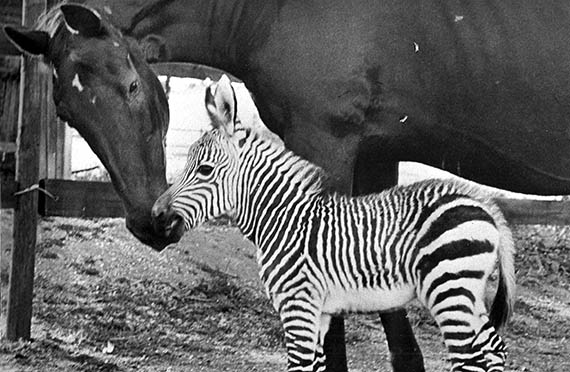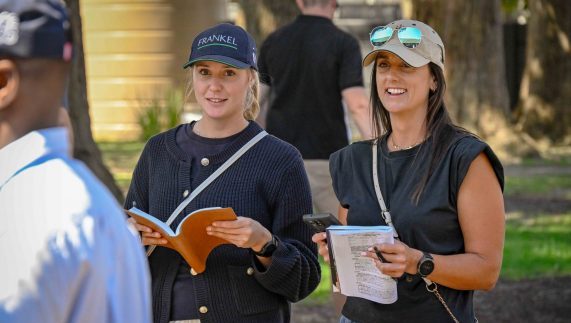
Sognatrice with her adopted Zebra
It is not often that links can be found between thoroughbreds and a rare endangered species – but that was the case with a Collingwood Stud’s broodmare and an orphaned Cape Mountain Zebra foal.
Some years ago, the Collingwood owned broodmare Sognatrice lost her foal, and owner Pat Schafer decided to use her as a foster mare. Glancing through the ads section of the newspaper that day, Pat happened see an orphaned foal advertised. However, the foal in the paper was not a thoroughbred.
The filly (born just a night before) was a Cape Mountain Zebra foal. The Cape Mountain Zebras, once endemic to the Western Cape, were at the time a highly endangered species, with fewer than 250 left alive. While still regarded as an endangered species, the Cape Mountain Zebra’s population has stabilized somewhat. The first foal born in captivity to the Namibian Windhoek One herd so Pat named her Winnie One. Winnie was quick to adopt the mare and Winnie adapted well to life at Collingwood.
Her new “mother” Sognatrice warmed quickly to her unexpected offspring, and the pair very quickly struck a powerful bound. Winnie spent a happy seven and a half months at Collingwood, before Pat introduced to her original home, the Good Hope Nature Reserve.
Winnie was slowly introduced back into the herd, spending her initial few weeks in a small camp with just a single zebra mare as company. She was eventually rehabilitated into the main herd of mountain zebras, and Winnie eventually settled back into her natural surroundings.
Pat, who grew very fond of Winnie One and had a special whistle to which the foal would respond. Even after a year with Pat’s many visits, she would recognize the whistle and come out of the herd. Winnie truly thrived in her new environment!
Pat, who grew very fond of the filly, would go to see her former orphan a few times, and admitted that Winnie was truly thriving in her new environment!
Great At Stud & On The Track
While many people will argue that racing merit is not key to a broodmare’s future success, it is interesting to note that many of history’s finest racemares went on to enjoy fruitful careers at stud.
Pretty Polly and Sceptre are widely considered two of the finest racemares in British history, and both foundered hugely important dynasties at stud. Selene, dam of leading sires Pharamond, Hunter’s Moon, Sickle and the immortal Hyperion, won 16 races including the Cheveley Park Stakes and Nassau Stakes – both of which races are now Group One contests.
Dual Breeders Cup winner Miesque produced six stakes horses including world leading sire Kingmambo, and highly successful local sire Judpot, as well as the Group One contender MIesque’s Son (sire of Eclipse Champion and KZN sire Miesque’s Approval).
Champion filly Eclair (winner of the now G1 Falmouth Stakes) produced top-class colt Khaled, himself an outstanding sire, as well as Emali (the ancestress of Blushing Groom).
Unbeaten US legend Personal Ensign (winner of the 1988 Breeders Cup Distaff) was named North America’s Broodmare of the Year in 1996, while the mighty Dahlia (a poster girl for why mares can have long racing careers and still excel at stud) bred no fewer than four Grade One winners. Dahlia is also the second dam of St Leger winner and successful Brazilian sire Nedawi (Rainbow Quest).
Northern Dancer’s dam Natalma won the (now Gr1) Spinaway Stakes before being disqualified. Her descendants have rewritten the history books, and include not only Northern Dancer but the highly inbred Danehill and uber successful sire Machiavellian (sire of Street Cry). The former US champion 2yo filly Numbered Account became an exceptional broodmare, whose offspring include Gr1 winner and top US sire Private Account.
Add the likes of Arc winner Urban Sea (dam of Galileo and Sea The Stars), Gr1 Matron Stakes heroine Fall Aspen (dam of four Gr1 winners including Timber Country and Fort Wood) and Horse Of The Year Moccasin (dam of five stakes winners), and it is hard to agree that racing class is not important in a broodmare.
Tapit vs War Front
Arguably North America’s two hottest sires are Tapit (Pulpit) and War Front (Danzig), both of whom stand for $150 000. Both stallions are fully booked, with both Tapit and War Front covering some outstanding mares in 2014.
But which is the better stallion? Interestingly, both horses share a common denominator, with both Tapit (Unbridled) and War Front (Rubiano) being produced by daughters of Fappiano stallions.
Tapit began his stud career at a fee of $15,000, while War Front started at Claiborne for a fee of $12,500. Statistically, Tapit (who stood his first season in 2005) has sired 49 stakes winners to date (6%), and he sports an AEI (Average Earnings Index of 2.2). By comparison, War Front, who retired to stud in 2007, has sired 28 stakes winners (8%), and has an AEI of 2.71.
War Front has also enjoyed success in Europe – with both Declaration of War (Juddmonte International) and War Command (Dewhurst Stakes) winning major Group One races in Britain last year. Remarkably, War Front’s first crop of foals (75 in number) produced 12 stakes winners (ie 16% of his first crop were black type winners.
These figures suggest that War Front has the edge over Tapit. However, in 2014 Tapit has enjoyed a quite remarkable season. The former Gr1 Wood Memorial winner, who currently leads the North American General Sires List, has been represented by no fewer than 8 stakes winners this year already, headlined by unbeaten Gr1 Florida Derby winner Constitution, and leading Kentucky Oaks hopeful Untapable.
Tapit, who is just 13 this year, already has nine registered sons at stud, and his 12 Grade One winners include no fewer than four Breeders Cup winners. He is a truly remarkable stallion.
The 12 year-old War Front (who has five sons registered at stud) has had a quieter start to the year, with his offspring including four stakes winners in 2014, but he does have last season’s top-class 2yos War Command and Giovanni Boldini representing him this season.









